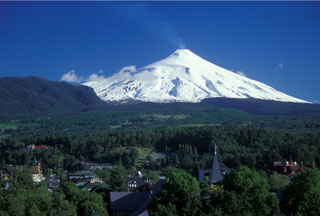Report on Villarrica (Chile) — 10 March-16 March 2010
Smithsonian Institution / US Geological Survey
Weekly Volcanic Activity Report, 10 March-16 March 2010
Managing Editor: Sally Sennert.
Please cite this report as:
Global Volcanism Program, 2010. Report on Villarrica (Chile) (Sennert, S, ed.). Weekly Volcanic Activity Report, 10 March-16 March 2010. Smithsonian Institution and US Geological Survey.
Villarrica
Chile
39.42°S, 71.93°W; summit elev. 2847 m
All times are local (unless otherwise noted)
Based on web camera views, the Buenos Aires VAAC indicated that on 11 March a diffuse gas-and-ash plume from Villarrica drifted near the crater. Ash was not detected on satellite imagery. That same day, SERNAGEOMIN reported that, during an overflight, scientists saw a typical-looking gas plume drifting SW and tephra deposits on the flanks.
Geological Summary. The glacier-covered Villarrica stratovolcano, in the northern Lakes District of central Chile, is ~15 km south of the city of Pucon. A 2-km-wide caldera that formed about 3,500 years ago is located at the base of the presently active, dominantly basaltic to basaltic-andesite cone at the NW margin of a 6-km-wide Pleistocene caldera. More than 30 scoria cones and fissure vents are present on the flanks. Plinian eruptions and pyroclastic flows that have extended up to 20 km from the volcano were produced during the Holocene. Lava flows up to 18 km long have issued from summit and flank vents. Eruptions documented since 1558 CE have consisted largely of mild-to-moderate explosive activity with occasional lava effusion. Glaciers cover 40 km2 of the volcano, and lahars have damaged towns on its flanks.
Sources: Buenos Aires Volcanic Ash Advisory Center (VAAC), Servicio Nacional de Geología y Minería (SERNAGEOMIN)

